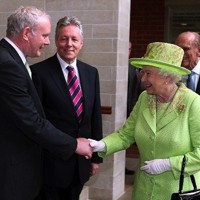Fifteen years ago, the peace process in Northern Ireland was at a critical juncture. With the IRA having restored its cease-fire at the end of July 1997, Sinn Fein was judged to be in compliance with the so-called Mitchell Principles and admitted to the peace talks that would eventually produce the Good Friday/Belfast Agreement (.pdf) in April 1998. However, Sinn Fein's entry into the process prompted the exit of Ian Paisley’s Democratic Unionist Party, which refused to negotiate with what it considered to be a terrorist group. A decade and a half later, the DUP and Sinn Fein co-exist in a coalition government in Northern Ireland, with the DUP’s Peter Robinson holding the post of first minister and Sinn Fein’s Martin McGuinness serving as deputy first minister.
Yet, in early September 2012, after a controversial decision by the Parades Commission to route a traditional Republican parade close to a Loyalist housing block, Belfast experienced three consecutive nights of rioting that pitted Loyalist and Republican communities in north Belfast against each other and the police. Responses to the rioting from leading politicians, including Robinson and McGuinness, illustrated how deep the divide between the communities in Northern Ireland remains.
This volatile co-existence highlights both how much and how little has changed in Northern Ireland since the conclusion of the historic agreement in April 1998 meant to settle a conflict that had lasted more than 30 years and cost more than 3,000 lives. The ups and downs of the peace process and the subsequent political process over the past 15 years have seen deadlock, near-collapse and renegotiation of the Belfast Agreement as Northern Ireland has moved slowly and often painfully toward a political normality in which disagreements are resolved within democratic institutions rather than by bomb attacks, knee-cappings and punishment beatings.

